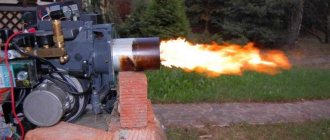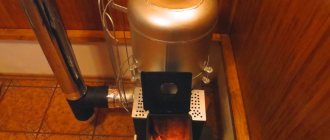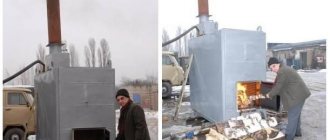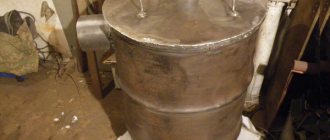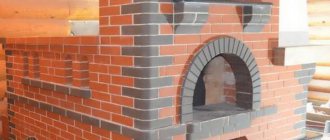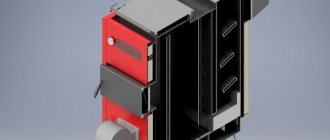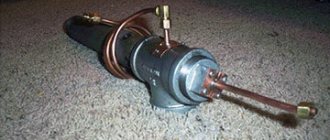Principle of operation
The advantage of biofireplaces is that they do not have a chimney and other elements inherent in built-in devices with portals. This eliminates the need to buy firewood or coal for ignition, cleaning the walls from soot and soot, as well as the smell of burning and smoke.
Mini fireplaces have two main functions: aesthetic and relaxing. Such devices will suit almost any interior, especially those made in high-tech style. Looking at the flames of the fire in the fireplace, a person can achieve inner peace and harmony, which is very important for the modern rhythm of life.
The design of a tabletop hearth consists of a firebox with burners and a frame. The fireplace works very simply. The fuel is poured into a special stainless steel tank. Using the lid you can adjust the intensity of the flame. The offset filling system prevents burns when adding biofuel to the tank. Due to the design of the walls, gases do not accumulate in the bio-fireplace, which eliminates sudden pops and explosions.
Fuel for a biofireplace and its consumption
The main fuel for all types of biofireplaces is ethanol. It is made from plant materials: wheat, rice or corn. In the process of processing these products, environmentally friendly raw materials are obtained, suitable for use in tabletop fireplaces. The combustion products from such fuel do not harm the environment, so heating devices can be used in rooms with children and people prone to allergies.
Due to the properties of ethanol, the flame does not emit sparks during combustion, which prevents the ignition of nearby objects. Biofuel also eliminates the presence of volatile substances, so the body of the biofireplace always remains clean.
Fuel consumption depends on the design of the burner in the fireplace. Tabletop models of biofireplaces burn about 200 milliliters per hour. Despite their compact size, such devices “eat up” more fuel material than wall-mounted or floor-mounted models with a fire regulator.
Ethanol - fuel for a desktop biofireplace
Fuel for biofireplaces is poured into containers of 2.5 and 5 liters. Based on the fact that the consumption of raw materials is on average 200 ml/h, you can calculate how much one bottle will last. It turns out that 2.5 liters is enough to provide a fireplace with continuous burning for 10 hours.
The absence of a chimney in a tabletop fireplace allows all the heat generated to remain indoors. This increases the efficiency by almost 100%, which is equal to the power of two operating electric heaters.
Advantages and disadvantages
Biofireplaces, unlike wood heating devices, have the following advantages:
- Environmentally friendly. Ethanol does not produce harmful substances during combustion, so there is no soot, soot, or carbon monoxide from the fireplace.
- Mobility. Most biofireplace models do not require permanent fixation, so they can be moved to another location.
- Safety. The fuel tank of biofireplaces is a special design that does not allow popping, emission of sparks, overheating and spillage of burning fuel, therefore the use of biofireplaces completely eliminates the risk of fire.
- Easy to operate and install. The biofireplace is easy to light and extinguish. It does not need a hood, a chimney, or a protective covering on the floor.
Disadvantages include:
- Minimum heat transfer;
- The need to arrange ventilation to replenish the reserves of burned oxygen;
- The high cost of biofuel.
Factors affecting work power
Everyone chooses the power indicator of a desktop biofireplace based on personal preferences. The heat that the device will produce depends on:
- fireplace models;
- quality of fuel material;
- flame size.
Most biofireplaces have a power ranging from 1 kW to 7 kW. Models with a long burner increase heating. Home appliances are usually manufactured with a thermal output of 2.5 kW. This is quite enough to heat a medium-sized room. However, this indicator may change up or down. For example, if a person is only interested in the aesthetic side, then a fireplace with a power of up to 1.5 kW is quite suitable. To heat a large room, it is better to choose units from 5 kW. It is better to obtain more detailed information on choosing the operating parameters of the fireplace from the seller at the time of purchase.
The second indicator that affects power is the quality of bioethanol. There are many fuel options, but they all must meet two requirements: have a clear liquid form and a percentage of combustible substance of at least 96%.
The third indicator of power consumption is the size of the flame. Most modern models of biofireplaces are available with the ability to adjust the size of the flame. This is done by sliding the lid onto the hole in the burner. The narrower it is, the smaller the fire will be and, accordingly, the heat generation will be reduced.
Types of heating blocks
Heating or fuel block is the second name for the burner. In fact, this is a bio-fireplace; everything else is decorative elements. These devices are available today in a wide variety of designs.
Those that are more expensive are equipped with a special damper that allows you to adjust the size of the flame, quickly extinguish it (to do this, just turn a special handle), and also prevents dust from getting into the fuel and the penetration of unpleasant odors into the room.
The most expensive models also have electronic control, that is, they are automated.
It is not possible to reproduce such a product at home.
In cheap varieties of biofireplaces, simple burners with a primitive design are installed.
They have to be extinguished using a special device; the intensity of combustion cannot be adjusted, and under certain conditions the user may hear an unpleasant odor. But these devices are very affordable, and most importantly, they are easy to make on your own.
An integral part of any heating unit, no matter how expensive or the most budget-friendly, is the fuel tank. When fuel burns, it can become very hot and even cause a fire in materials in contact with it.
Therefore, the safest burners are those in which this tank is placed in a shell, that is, the fuel tank is like a container with a double bottom.
Fuel block Wasat 1100
To ensure longer combustion of a portion of fuel, some non-flammable absorbent material having a fibrous or porous structure is sometimes placed in the container containing it. True, such a solution cannot be called economical, since in this case the fuel does not burn out completely - part of it remains in the filler.
For ease of use, the heating units are equipped with a scale indicating the minimum and maximum fuel levels, as well as overflow protection.
The dimensions of these devices can vary within a very wide range - from 25 cm to several meters.
Those who live in non-gasified settlements know firsthand why a diesel burner is needed. Do-it-yourself diesel burner - manufacturing tips, read carefully.
Step-by-step instructions for making a fireplace with your own hands are presented here.
Since a fireplace is not only a heating device, but also an important element of the interior, a lot of attention is paid to its cladding. Follow the link for useful tips for those who want to cladding a fireplace with their own hands.
Nuances of use in a residential area
A tabletop biofireplace for an apartment allows you to enjoy the view of the fire whenever you wish. It can be installed anywhere in the apartment, especially since the safety of the design allows the device to be used indoors with children. Despite this, there are some requirements for biofireplaces:
- the room should be well ventilated;
- It is not recommended to place the fireplace in a draft;
- models with high thermal power cannot be installed in rooms with an area of less than 30 sq.m., because they will heat up too much;
- in poorly ventilated areas, you need to make an additional source of ventilation to bring in fresh air.
A desktop biofireplace should be used in a room that is well ventilated.
Caring for biofireplaces is very simple.
The heating unit is cleaned with ordinary tap water. Tabletop models are easy to use and can be moved from place to place when necessary.
Criterias of choice
Biofireplaces are chosen not only based on external parameters. The technical side of the issue is important. Based on this, you can select a fireplace based on the following characteristics:
- device size. Depends on where the fireplace will be installed. Small compact models are suitable for office use, but for home use you can choose a larger option;
- power. This indicator depends on a combination of factors. These are the dimensions of the structure, its location, the volume of the fuel tank and the number of burners;
- type of control system. The simplest fireplaces are controlled manually. More expensive options may be equipped with a control panel;
- fuel type. Bioethanol can be in the form of a clear liquid, gel or tablets. Before purchasing, you need to clarify what material the selected fireplace uses.
If you buy a biofireplace to heat your home, you should remember that it is not a complete replacement for heating systems, but only complements them. In terms of its power, the hearth cannot work stronger than solid fuel and gas stoves.
Primary requirements
First of all, we need to decide what kind of device we need: a large bio-fireplace for installation on the floor, a hanging version, or a very small device made for use on a table, work table or coffee table. To work, we will need design drawings, sketches and sketches of the general appearance of the biofireplace.
Please note that all biofireplaces operate on the same principle, and the main differences are their appearance and functionality (control, sound).
Quality should be chosen as the main criterion for production. It is the quality that will serve as an excellent guarantee for long-term use of the device and ensure maximum safety of its operation. Thus, even a home-made bio-fireplace burner should work properly, without failures, because the heating unit of the device is the most important.
When designing and creating a burner for a biofireplace, you should pay attention to the following aspects:
- When selecting materials for burning biofireplaces, you should always start from high-quality, fire-safe options. In particular, hardened metal will be the optimal solution for the burner, since along with excellent heat-resistant characteristics, it is also quite malleable for processing. Whatever you choose from, always analyze the safety factors and ease of working with the material. In this regard, ceramics are beautiful, but not so accessible for processing.
- When developing a drawing of a biofireplace burner, experts advise paying special attention to the firebox and fuel storage tank. It is advisable to make compartments for bioethanol with a thick bottom and walls to prevent possible disruptions in the operation of the system. You must make your bio-fireplace safe for use, minimize the likelihood of deformation of its body, and eliminate the possibility of fuel spilling from the tank.
The main part of any biofireplace
- In addition to safety, other nuances in the operation of the device should be taken into account. For example, to evenly distribute the fire inside the apparatus, you can place a metal mesh over the burner. It will additionally become the basis for decorative elements. It is also important to consider the distance from the burner to the walls of the bio-fireplace protective screen. It is advisable to maintain it at least 10-15 centimeters. If the biofireplace design involves several burners, then they must be placed at some distance from each other.
- The internal structure of a burner for a biofireplace is simple; the wick plays a very important role here, which connects the fuel block of the device to the external part. During operation of the device, bioethanol impregnates the fabric of the wick, thereby rising from the reservoir to the hearth. You can use a string as a wick; you should carefully lay it inside the device and bring it out in an inconspicuous place outside, hidden by decorative elements.
- When assembling the device, you should carefully check all fastenings for reliability. If the assembly diagram is drawn up incorrectly, the design of the device should be improved and a new option should be considered.
- When the biofireplace firebox is assembled, it is necessary not only to visually evaluate the result obtained, but also to make sure that there are no deformations of the device that appeared during assembly. If there are no visible violations, then you can continue to prepare the device for operation.
- When thinking through the design of a biofireplace and developing drawings, you should decide on the appearance of the device. An important role here will be played by a portal or protective screen made of fire-resistant glass, built in such a way that there will be a view of the fire from all sides and angles.
Good to know: Corner bio-fireplace, its advantages and use in the interior
Technology for making a desktop biofireplace yourself
Despite the simplicity of the design and the minimum of equipment required for its manufacture, purchased bio-fireplaces are not cheap at all. To save money, you can try to design the device yourself. You don’t need any special skills or expensive materials for this.
To work you need to prepare the following:
- metal can;
- metal box;
- heat-resistant glass;
- glass cutter;
- material for decoration;
- metal mesh;
- lace;
- sealant.
The amount of glass is calculated based on the size of the future fireplace. It is important that it is not very thin, otherwise it may crack due to the high combustion temperature.
A tin or metal can from coffee, tea, etc. is suitable for the burner. A small piece of metal mesh is needed for fastening inside the fireplace. Decorative stones are placed on it, so the cells in it should be as small as possible.
Decorating a burner for a biofireplace
In the finished body of a homemade bio-fireplace, you can easily change the filling. Suitable accessories:
- Stones: having the same or different sizes, smooth or textured, transparent or colored.
Stones can be placed not only on the surface of the grate, but also outside.
- Ceramic logs: selected according to size will imitate a real fire.
Stylized objects laid out nearby will help to emphasize the atmosphere, for example, tools for lighting and extinguishing a bio-fireplace, a poker and tongs, as well as fuel in decorative and safe packaging.
Blueprints
Before you start making a bio-fireplace with your own hands, you need to draw up drawings of the future design. For each individual component, its own scheme is developed.
When designing the burner, you need to consider the type of glass used for the frame. If it is not heat-resistant, then the distance from it to the burner should be increased by more than 15 cm. Without taking this indicator into account, there is a risk that it will crack during the first use.
The metal for the burner must be thicker than 2 mm. Material that is too thin will burn out over time. If you plan to build a dimensional model, then it is better to choose a tank in a specialized store.
In the schematic representation of the fireplace, it is necessary to indicate the number of burners. It depends on personal preference and the size of the room. For a room measuring 30 sq. m. you can install no more than two burners. When the drawings of the biofireplace are ready, you can begin its construction.
Frame installation
The step-by-step assembly of a desktop biofireplace with your own hands begins with the installation of a glass screen. Depending on the size of the metal box, the glass is marked. After this, four walls of a certain length are cut out with a glass cutter and connected to each other with sealant. When the adhesive composition has completely hardened, the seams on the glass frame are cleaned. The finished casing is placed in a metal box that acts as a fuel block.
Inside the box, a metal can “sits” on the sealant and is covered with a mesh cut out in accordance with the area of the inner space of the box. At this stage, the installation of the frame will be completed.
Frame cladding and fire-resistant material coating
Special tiles for lining the inside of the biofireplace must be made of fire-resistant material. Any hard, non-flammable material will do for this. If desired, the metal box is coated with heat-resistant paint. A good option would be cladding with terracotta tiles or mineralite. But such materials are not cheap, so you can leave the box in its original form.
The lining of a desktop biofireplace must be made of fire-resistant material
Installation
When the body of the desktop mini bio-fireplace is completely ready, fuel is added to it and the wick is lowered from the cord. One end of it can be passed between the stones laid on the grate. The main thing is to choose the cord of the required length so that it reaches the fuel. Now you can light the burner and enjoy the sight of the playing flame.
It is important that the bio-fireplace stands on a flat surface. You can check this using a building level.
Instructions for making a wall bio-fireplace: from preparation to implementation
The procedure for creating a wall-type structure is practically no different from floor or tabletop options
The procedure for creating a wall-type structure is practically no different from floor or tabletop options. Initially, the design is thought out, the type of bio-fireplace is selected - straight or corner. Based on it, a drawing is developed, where fire safety is taken into account when sizing. In other words, first of all, the distance from the hearth to the walls and mantel of the fireplace is determined (at least 15 - 20 cm). Then markings are applied to the walls and construction work begins. It is necessary to pay attention that such a bio-fireplace is immediately installed on the wall surface.
As in previous variations, calculations must be performed taking into account fire safety
To do this you will need tools and materials:
- GKL;
- metal profile with rack and guide elements;
- self-drilling screws, dowel-nails;
- screwdriver;
- sheets of glass;
- fireproof material for insulation;
- ceramic tiles for finishing work;
- heat-resistant adhesive composition;
- grout;
- decor
The process is carried out in stages:
- Fastening UD profiles according to the markings, into which rack parts are then inserted. In this case, the structure is secured with self-tapping screws. The entire frame is assembled in the same way. The main thing is not to forget about installing double internal walls of the bio-fireplace, which will make it possible to slightly reduce the temperature at the very base of the fireplace.
- Laying material for insulation into the walls of the frame.
- Covering with prepared plasterboard sheets, which are secured with self-drilling screws.
Considering that when a fire occurs, the temperature at the very base of the fire increases to 150 C, it must be made of a hard material that does not burn: heat-resistant glass, ceramics or metal.
- Finishing works. At this step, you need to apply a gypsum-based plaster mixture, and then cover the frame, except for the place under the burner, with tiles, tiles or wild stone, depending on your capabilities and desires.
- Grouting joints.
- Installation of a burner, which can be used either as a purchased structure or as an ordinary iron glass with a wick lowered into it.
- Preparation and installation process of a fireplace grate or protective glass. The latter can be bought in a store in the form of a specialized box without a lid, or you can create it yourself from a sheet of glass, combining the parts with sealant and waiting for it to dry completely.
When using the bio-fireplace for the first time, the burner bowl must be filled only to a third of its depth, leaving a distance from the fuel to the edges (at least 2 cm). If drops or streaks appear on the outside, they must first be wiped off with a wet cloth. When lighting the wick, you should prepare for the fact that a gas flash may appear at the moment of ignition.
It is better to buy fuel in special stores, giving preference to products from well-known manufacturers. It should be kept strictly at a temperature of 20 degrees, and topped up only when the bio-fireplace is not functioning and the flame is not burning.
The working time of the biofireplace depends on the capacity of the bowl. If it becomes possible to extinguish the flame in advance, it is necessary to use specialized extinguishers, which can always be purchased in a store or made without outside help from metal. They are structures with a handle, at the end of which there is a burner cover.
Safety rules for use
The bio-fireplace, due to the presence of an open flame, must be operated under conditions of strict adherence to fire safety regulations. To do this, the following conditions must be met:
- the fireplace is located at a distance of at least 40 cm from flammable materials;
- with open windows, if there is a draft, curtains or curtains should not get into the open flame;
- it is necessary to exclude access of animals and children to the bio-fireplace;
- if the fireplace will be located near a wall, it should be covered with heat-insulating material, for example, mineral wool or fire-resistant tiles;
- the biofireplace requires oxygen, so the room must be well ventilated.
After purchasing or independently assembling a tabletop biofireplace, you need to buy special fuel for it.
You cannot use raw materials that are not intended for fireplaces of this type. Their combustion products can poison the air and the residents of the house. Refuel the bio-fireplace only when the fire is extinguished and the burner has completely cooled down. Fuel is added to the tank using a special pump or funnel. The tank should be a maximum of 2/3 full. In cases of ethanol splashing, wipe the drops with a dry cloth.
No. 1. How does a biofireplace work?
Biofireplace is a relatively new invention. Its author is considered to be the Italian Giuseppe Lucifora, who designed the first bio-fireplace in 1977. Did he think then that his invention would become so popular! Today, biofireplaces are actively used in the interior design of city apartments and country houses. They are often installed outdoors, in a summer cottage, for example. What caused the device to become so widespread? To answer this question, you need to understand the operating principle of a biofireplace and its main components.
A bio-fireplace is designed completely differently from a regular wood-burning fireplace. To produce a flame, special fuel (bioethanol) is used, which is poured into the tank and ignited. The fuel burns without emitting carbon monoxide and other harmful products. That's it in short. To delve deeper into the process of how a biofireplace works, you need to study its structure:
- the burner is made of non-combustible materials (steel, ceramics, stone) and decorated with sand, real stone, or imitation wood and coal. All elements that cover the burner must be non-flammable;
- the fuel tank into which bioethanol is poured has a volume from 0.7 l to 3 l, in rare cases more. The larger the tank and the more fuel that can be poured into it, the longer the continuous combustion process will be. On average, 1 liter of fuel is enough for 2-3 hours of fireplace operation. You can add a new portion of fuel only after the device has cooled down. The fire is ignited by bringing a special long lighter. You can use fireplace matches, but it is dangerous to use rolled pieces of paper. In automatic biofireplaces, the ignition process is simpler - by pressing a button;
- Biofireplace fuel is obtained from plant crops rich in sugar. When burned, it breaks down into carbon dioxide and water vapor. There is no soot, soot or smoke, so there is no need to install a chimney, but good ventilation will not hurt. Experts compare a biofireplace with a regular candle in terms of the level and nature of emissions. Some biofireplaces burn bioethanol vapor;
- the portal is usually made of tempered glass. This material withstands heat and provides you with unhindered admiration of the fire from different angles. The power and height of the flame can be adjusted thanks to a special damper, but the flames will never be higher than the glass barrier;
- the frame is the skeleton of the biofireplace. All functional parts of the product, as well as decor, are attached to it. The frame ensures stability on the floor and fastening to the wall (for wall-mounted models). The decor can be different, it completes the appearance of the fireplace and makes it a bright detail of the interior;
- There may be some additional components that significantly expand the functionality of the biofireplace. For example, a system of sensors that monitor operation, sound design, buttons that turn on automatic fireplaces. Some devices can be controlled by remote control or even using a smartphone.
The intensity of the flame is regulated by flap covers. When you move it, the flow of oxygen to the burner decreases or increases, which determines how large and powerful the flames will be. By cutting off access to oxygen, you can completely extinguish the fireplace.
A biofireplace is bought and installed, first of all, for the beauty and feeling of home comfort. However, the benefits of it are not limited to this. Since there is a real fire in the fireplace, heat emanates from it. A biofireplace can be compared to a heater with a power of up to 3 kW; it can easily heat the air in a relatively small room (about 30 m2), but it is not considered as a replacement for a heater, and tempered glass is not able to retain the accumulated heat for a long time.
If in a traditional fireplace the heat loss due to the exhaust system reaches up to 60%, then in a biofireplace the losses account for only 10% - the remaining 90% goes to heating the room.
As for ventilation. A chimney for a biofireplace is not needed, but high-quality ventilation must be provided. However, this requirement also applies to apartments where there is no bio-fireplace. If you feel that your home ventilation is not coping well, you will have to sometimes open the windows and ventilate.
Biofireplaces can be very different in shape, so this detail will fit perfectly into any interior style, from classic to high-tech.
